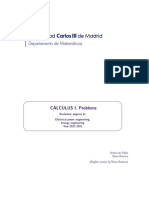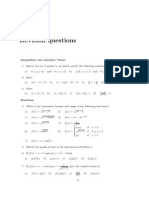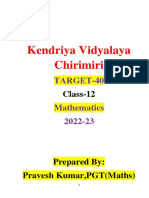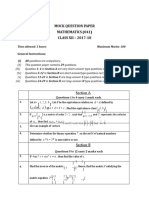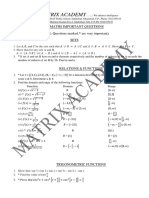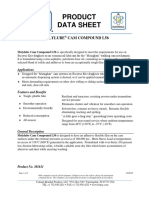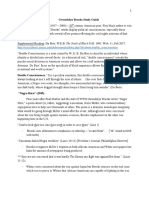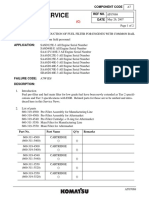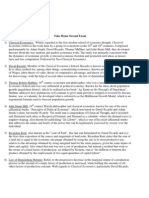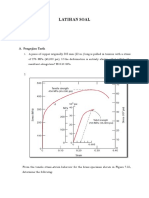Minimum requirements concerning mathematics in the
Business Engineering program at KU Leuven and USL-B
1 Example problems of basic algebraic skills
1. Factor over R assuming m, n ∈ N:
(a) a6 + b6 + a2 b2 (a2 + b2 ) 1 2 2 1 1 1 1
(e) x + xy + y 2 + z 2 + xz + yz
1 1 9 15 25 4 3 5
(b) x4m − y 8m (f) x n−1
− 4x 2n−1
+ 4x 3n−1
4 9
(c) 9a + 4b − 6ac − 4bc + c2 + 12ab
2 2 (g) x2m+4 + 2xm+2 y + y 2 + 5xm+2 z + 5yz
(d) 4x2 − 12xy + 25z 2 − 30yz + 20xz + 9y 2 (h) a8 − 4a6 − 2a5 + 8a3 + a2 − 4
2. Find the zeroes of the following polynomial functions:
(a) x3 − 3x2 + 4 (c) 5x4 + x3 − 4x2 − x − 1
(b) x4 − 7x3 + 18x2 − 20x + 8 (d) x5 + 3x4 − 5x3 − 15x2 + 4x + 12
3. First, find a, b ∈ R for which − 12 and 31 are zeroes of f : R → R : f (x) = ax3 −16x2 −5x+b.
Next, determine all remaining zeroes.
4. Simplify following expressions:
16x2 − 9y 2 2 3 5
(a) (c) + −
16x2 − 24xy + 9y 2 x + 1 (x + 1)(x − 1) x − 1
3x4 − x2 y 2 − 2y 4 � x xy � z
(b) (d) + ·
10x4 + 15x3 y − 10x2 y 2 − 15xy 3 z z xy
5. Solve the following equations in one variable x over R considering all possible values for
the unknown parameters a, b ∈ R:
(a) (a − 1)x − (1 − a)x = 0 ax − 2 1 − x 5x
(c) + =
3 2 6
2
(b) ax + a = bx + b (d) a x + 1 = a + x
6. Solve the following inequalities in one variable x over R considering all possible values for
the unknown parameters a, b ∈ R:
(a) ax + b < 0 ax − 1 1 − x x
(c) − <
2 3 6
2
(b) mx − 3 ≤ 2x + m (d) a x + 4 ≥ 2 − x
7. Solve the following systems of equation in two variables x, y over R:
4x − 3
9
(
2x − y − 4 = 0 =
(a)
y−2 2
x+y−5=0 (b)
6x − 2 5
=
4y + 1 4
1
� 2x − 1 y + 2
x+3
+ =4
=5
3 4 y−5
(c) (d)
x+3 − x−y =3
x−1 1
=
2 3
y+3 9
2 Example problems of elementary functions
1. Prove the following expressions:
(a) aln b = bln a for a, b ∈ R+ logb c
0 (b) logab c = for a, b, c ∈ R+
0
1 + logb a
and ab 6= 1 6= b
2. Simplify:
√
(a) e3 ln 2−2 ln 5 e3 e
(b) 1/3
e
3. Solve the following equations for x ∈ R+
0:
(a) ln x = 13 (ln 16 + 2 ln 2) (b) 3x = e2
1 π
4. Compute cos x, tan x and cot x if it is known that sin x = 2
and 2
< x < π.
r−1
5. Determine the conditions for r ∈ R such that there exists some x ∈ R for which sin x = 2
and cos x = r+1
2
.
6. Simplify:
√
sin x cos x (c) 1 + 2 sin x cos x
(a) +
cos x sin x
1 1
(b) + (d) cos4 x − sin4 x + 1
1 + tan x 1 + cot2 x
2
7. Prove the following expressions:
1 − tan2 x 2 tan x
(a) = cos2 x − sin2 x (b) = 2 sin x cos x
tan2 x + 1 1 + tan2 x
3 Example problems of calculus
1. Compute the following limits:
x2 − 4x + 2 ln x
(a) lim (c) lim
x→0 x2 − x − 4 x→+∞ x
√ √
(b) lim (3x − x2 − x + 1) (d) lim (3x − x2 − x + 1)
x→+∞ x→−∞
2. Compute the first and second order derivatives of the following functions:
(a) f : R → R : x 7→ 2x5 − 4x3 + 7 1
(c) f : R → R : x 7→
1 + x2
(b) f : R → R : x 7→ x2 sin x (d) f : R → R : x 7→ (1 − 2x)7
2
� (e) f : ]0, 1[ → R : x 7→ −x ln x (f) f : R → R : x 7→ | sin x|
3. Determine domain, x- and y-axis intercepts, asymptotes, first and second derivatives with
sign tables of the following functions. Then apply this information to sketch the graph.
√
(a) f : R → R : x 7→ x + x2 + 1 x2 − 1
(b) f : R \ {2} → R : x 7→
x−2
4. Compute the following integrals:
Z Z 5
dx
Z
3 2
(a) (x − 5x + 6) dx (e) (i) (3x2 − 4) dx
2x + 7 2
Z Z Z π
dx
(b) (1 + sin x) dx (f) √ (j) x sin x dx
5x2 − 1 0
Z 4
x2 ex + (ex − 1)
Z Z
(c) dx (g) x cos x dx (k) (x − 4)2 dx
1 + x2 0
Z −1
dx
Z Z
(d) (5x − 6)5 dx (h) (x − 1)2 ex dx (l)
−3 x2
4 Example problems of linear algebra
1. For the following matrices, determine (a) the transposed matrix, (b) the squared matrix
(c) the inverse matrix. Check the correctness of the obtained inverse matrix by applying
the definition of the inverse matrix of a given matrix.
3 −4 2 0 1 3
(a) 5 1 −8 (b) 1 −1 −5
−4 −1 7 3 1 −2
2. Solve the following systems of equations using the Gaussian elimination method:
x + 2y − z + 3t = 1 x + 4y + z − 2t = 1
(a) 2x + y − z − t = 3 (b) x − z + 2t = 1
−x + z + t = −1 2x − y + z − t = −2
3. Solve the following systems of equations using the Gaussian elimination method consid-
ering all possible values for the unknown parameter a ∈ R:
(
x + ay = a + 1 (a + 2)x + y + z = a
(a)
ax + y = 2 (b) x + (a + 2)y + z = 1 − 2a
x + y + (a + 2)z = a − 1
5 Example problems of complex numbers
1. Compute the complex conjugate, modulus and inverse of the following complex numbers:
√
(a) 1 (b) i (c) 1 + 3 i
3
� 2. Simplify:
1 + 2i (b) (2 − i)3 (1 − i)(−2 + 3 i)
(a) (c)
3−i (5 − 2 i)(1 + i)
3. Solve the following equations over C:
(a) z 2 = −2 (b) z 2 = 3 + 4 i (c) z 2 = −5 − 12 i
6 Example problems of planar geometry
1. Determine the equation of the straight line through the point p perpendicular to the
straight line L:
(a) p(−2, 3) and L : 3x − 4y − 2 = 0 (b) p(0, −4) and L : 2x + y + 4 = 0
2. Determine the equation of the straight line through the points p1 and p2 :
(a) p1 (2, 3) and p2 (4, 5) (b) p1 (−4, 4) and p2 (−4, 5)
3. Determine the distance from the point p(2, 4) to the following straight lines:
√ √
(a) L : 3x − 4y = −8 (b) L : 3x − 2y + 8 = 0
4. Determine the distance between the points p1 and p2 :
(a) p1 (1, 3) and p2 (−2, −1) (b) p1 (3, 4) and p2 (4, 5)
5. Determine the equation of the circle with the origin as centre and radius 5. Check if
p1 (3, 4), p2 (5, 0) and p3 (2, 6) are located on this circle.
6. Determine the centre and radius of the circle with equation x2 − 6x + y 2 − 4y + 12 = 0.
7. Check if the following vectors p~ and ~q are perpendicular:
(a) p~(1, 3) and ~q(−2, −1) (c) p~(0, 3) and ~q(5, 0)
(b) p~(3, 4) and ~q(4, −3) (d) p~(5, −6) and ~q(−1, − 65 )
8. Check if the following straight lines are parallel, coincident or intersecting. In the last
case also calculate the intersection point.
(a) L : x − y = 1 (b) L : x − y = 1 (c) L : x − y = 1
K : 2x − 2y = 2 K : 2x − 2y = 1 K :x+y =1
4
�7 Example problems of mathematical reasoning
1. Does the largest real number strictly smaller than 1 exist? Support your answer with a
mathematically correct reasoning.
2. Find all positive integers n for which n3 − n is divisible by 3. Convince yourself that you
have found all possibilities by using a mathematically correct reasoning.
3. Do there exist integers x, y and z for which 6x + 9y − 15z = 107? Mathematically prove
your answer.
4. Let f be an increasing real valued function of one variable. This means that f : R → R
with f (x2 ) ≥ f (x1 ) for all x1 , x2 ∈ R with x2 ≥ x1 . What can you conclude about the
number of solutions x ∈ R of the equation f (x) + x3 = 0? Support your answer with a
mathematically correct reasoning.
5. Are the following functions injective (i.e., one-to-one)? If so, determine the corresponding
inverse function.
(a) f : R → R : x 7→ f (x) = 3x − 2 (c) h : R+ → R : x 7→ h(x) = x2 + 1
(b) g : R → R : x 7→ g(x) = x2 + 1
6. Do there exist geometric sequences (xn )n∈N satisfying xn+2 +xn+1 −6xn = 0 for all n ∈ N?
If so, determine all these sequences. If not, prove mathematically that these sequences
do not exist.
7. The quantity demanded of a good or service depends on its price. The price elasticity
of demand measures the sensitivity of the quantity demanded of a good or a service
to changes in its price. It is defined as the ratio of the percentage change in quantity
demanded to the percentage change in price of the good or service. Assume that if the
price of a good rises from 8 to 9 EUR, then the quantity demanded of the good decreases
from 120 units to 100 units. Calculate the price elasticity of demand of this good.

